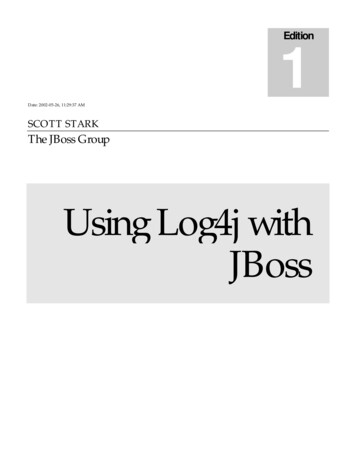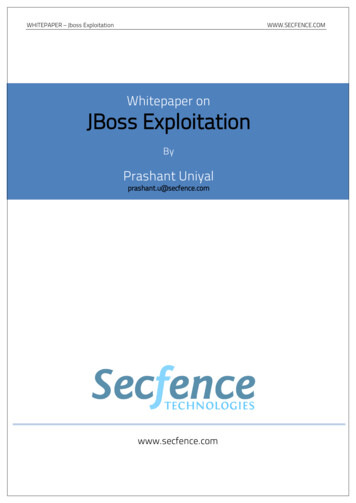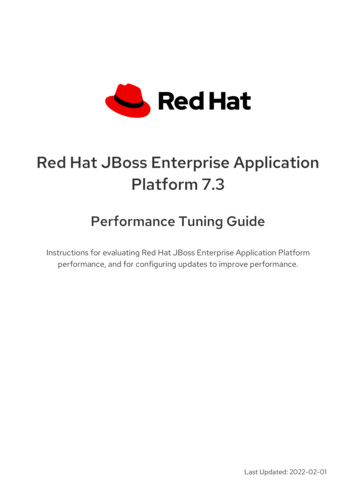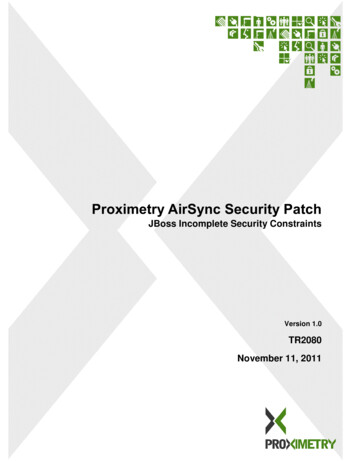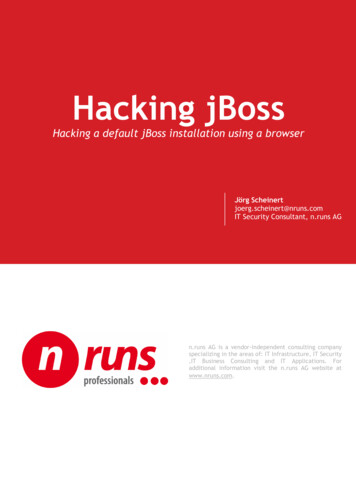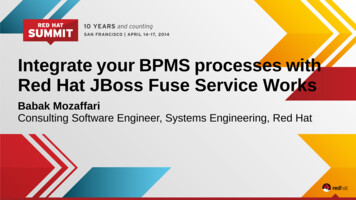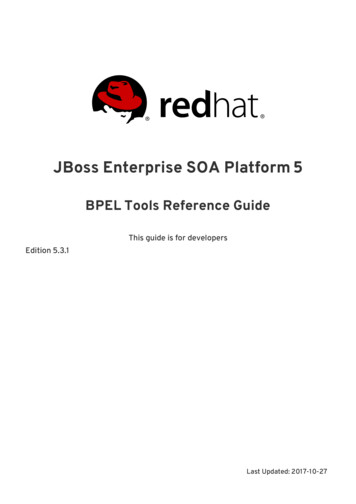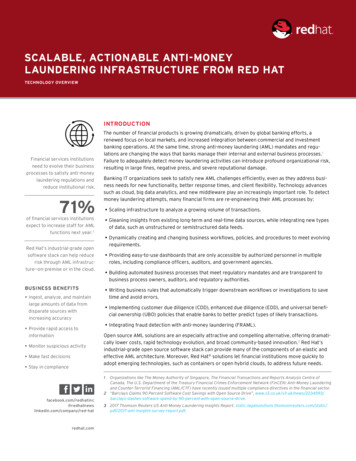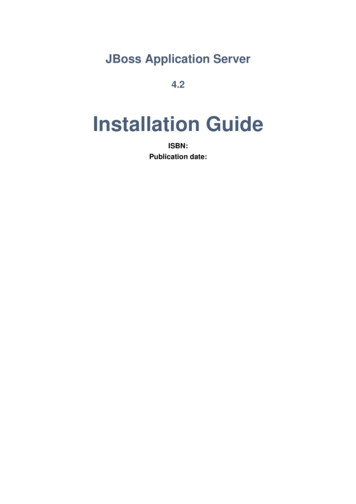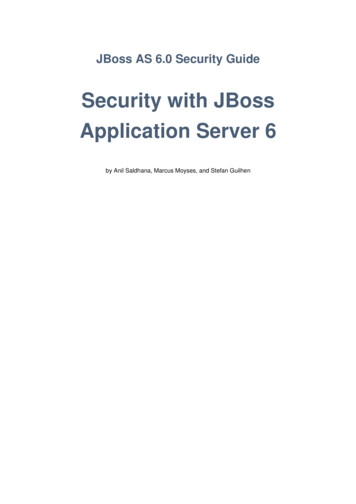
Transcription
JBoss AS 6.0 Security GuideSecurity with JBossApplication Server 6by Anil Saldhana, Marcus Moyses, and Stefan Guilhen
I. Security Overview . 11. J2EE Declarative Security Overview . 31.1. Security References . 31.2. Security Identity . 51.3. Security roles . 71.4. EJB method permissions . 81.5. Web Content Security Constraints . 131.6. Enabling Declarative Security in JBoss . 162. Introduction to JAAS . 192.1. The JAAS Core Classes . 192.1.1. The Subject and Principal Classes . 192.1.2. Authentication of a Subject . 203. JBoss Security Model . 253.1. Enabling Declarative Security in JBoss Revisited . 294. The JBoss Security Extension Architecture . 354.1. How the JaasSecurityManager Uses JAAS . 364.2. The JaasSecurityManagerService MBean . 394.2.1. The JNDIBasedSecurityManagement Bean . 434.3. The JaasSecurityDomain Bean . 43II. Security Domains and Components . 475. Static Security Domains . 496. Loading Static Security Domains . 537. Dynamic Security Domains . 558. Authorization Stacks . 599. Deployment-level Role Mapping . 7510. JBoss Login Modules . 7710.1. Using Modules . 7710.1.1. Password Stacking . 7710.1.2. Password Hashing . 7810.1.3. Unauthenticated Identity . 8010.1.4. Principal Class . 8010.1.5. UsersRolesLoginModule . 8010.1.6. DatabaseServerLoginModule . 8210.1.7. LdapLoginModule . 8410.1.8. LdapExtLoginModule . 8910.1.9. BaseCertLoginModule . 9110.1.10. IdentityLoginModule . 9410.1.11. RunAsLoginModule . 9510.1.12. ClientLoginModule . 9610.2. Custom Modules . 9610.2.1. Custom LoginModule Example . 98III. Encryption and Security . 10311. Java Security Manager . 10512. Encrypting EJB connections with SSL . 111iii
JBoss AS 6.0 Security Guideiv12.1. SSL Encryption overview .12.1.1. Key pairs and Certificates .12.2. Generate encryption keys and certificate .12.2.1. Generate a self-signed certificate with keytool .12.2.2. Configure a client to accept a self-signed server certificate .12.3. EJB3 Configuration .12.3.1. Create a secure remoting connector for EJB3 .12.3.2. Configure EJB3 Beans for SSL Transport .12.4. EJB2 Configuration .13. Masking Passwords in XML Configuration .13.1. Password Masking Overview .13.2. Generate a key store and a masked password .13.3. Encrypt the key store password .13.4. Create password masks .13.5. Replace clear text passwords with their password masks .13.6. Changing the password masking defaults .14. Overriding SSL Configuration 2515. Encrypting Data Source Passwords .15.1. Secured Identity .15.1.1. Encrypt the data source password .15.1.2. Create an application authentication policy with the encryptedpassword .15.1.3. Configure the data source to use the application authenticationpolicy .15.2. Configured Identity with Password Based Encryption .16. Encrypting the Keystore Password in a Tomcat Connector .16.1. Medium Security Usecase .17. Using LdapExtLoginModule with JaasSecurityDomain .18. Firewalls .19. Secure Remote Password Protocol .19.1. Understanding the Algorithm .19.2. Configure Secure Remote Password Information .19.3. Secure Remote Password Example .20. Consoles and Invokers .20.1. JMX Console .20.2. Admin Console .20.3. HTTP Invokers .20.4. JMX Invoker .20.5. Remote Access to Services, Detached Invokers .20.5.1. A Detached Invoker Example, the MBeanServer Invoker AdaptorService 59159159160163
Part I. Security OverviewSecurity is a fundamental part of any enterprise application. You need to be able to restrict who isallowed to access your applications and control what operations application users may perform.The Java Enterprise Edition (J2EE) specification defines a simple role-based security model forEnterprise Java Beans (EJBs) and web components. The JBoss Security Extension (JBossSX)framework handles platform security, and provides support for both the role-based declarativeJ2EE security model and integration of custom security through a security proxy layer.The default implementation of the declarative security model is based on Java Authentication andAuthorization Service (JAAS) login modules and subjects. The security proxy layer allows customsecurity that cannot be described using the declarative model to be added to an EJB in a way thatis independent of the EJB business object.
Chapter 1.J2EE Declarative Security OverviewRather than embedding security into your business component, the J2EE security model isdeclarative: you describe the security roles and permissions in a standard XML descriptor. Thisisolates security from business-level code because security tends to be more a function of wherethe component is deployed than an inherent aspect of the component's business logic.For example, consider an Automatic Teller Machine (ATM) component used to access abank account. The security requirements, roles, and permissions of the component will varyindependently of how you access the bank account. How you access your account informationmay also vary based on which bank is managing the account, or where the ATM is located.Securing a Java EE application is based on the specification of the application securityrequirements via the standard Java EE deployment descriptors. You secure access to EJBs andweb components in an enterprise application by using the ejb-jar.xml and web.xml deploymentdescriptors. The following sections look at the purpose and usage of the various security elements.1.1. Security ReferencesBoth EJBs and servlets can declare one or more security-role-ref elements as shown inFigure 1.1, “The security-role-ref element”. This element declares that a component is usingthe role-name value as an argument to the isCallerInRole(String) method. By using theisCallerInRole method, a component can verify whether the caller is in a role that hasbeen declared with a security-role-ref/role-name element. The role-name element valuemust link to a security-role element through the role-link element. The typical use ofisCallerInRole is to perform a security check that cannot be defined by using the role-basedmethod-permissions elements.Figure 1.1. The security-role-ref elementExample 1.1, “An ejb-jar.xml descriptor fragment that illustrates the security-role-ref elementusage.” shows the use of security-role-ref in an ejb-jar.xml.3
Chapter 1. J2EE Declarative S.Example 1.1. An ejb-jar.xml descriptor fragment that illustrates thesecurity-role-ref element usage. !-- A sample ejb-jar.xml fragment -- ejb-jar enterprise-beans session ejb-name ASessionBean /ejb-name . security-role-ref role-name TheRoleICheck /role-name role-link TheApplicationRole /role-link /security-role-ref /session /enterprise-beans . /ejb-jar Example 1.2, “An example web.xml descriptor fragment that illustrates the security-role-refelement usage.” shows the use of security-role-ref in a web.xml.Example 1.2. An example web.xml descriptor fragment that illustrates thesecurity-role-ref element usage. web-app servlet servlet-name AServlet /servlet-name . security-role-ref role-name TheServletRole /role-name role-link TheApplicationRole /role-link /security-role-ref /servlet . /web-app 4
Security Identity1.2. Security IdentityAn EJB has the capability to specify what identity an EJB should use when it invokes methodson other components using the security-identity element, shown in Figure 1.2, “The securityidentity element”Figure 1.2. The security-identity elementThe invocation identity can be that of the current caller, or it can be a specific role. The applicationassembler uses the security-identity element with a use-caller-identity child element toindicate that the current caller's identity should be propagated as the security identity for methodinvocations made by the EJB. Propagation of the caller's identity is the default used in the absenceof an explicit security-identity element declaration.Alternatively, the application assembler can use the run-as/role-name child element to specifythat a specific security role given by the role-name value should be used as the security identityfor method invocations made by the EJB. Note that this does not change the caller's identity asseen by the EJBContext.getCallerPrincipal() method. Rather, the caller's security roles areset to the single role specified by the run-as/role-name element value. One use case for therun-as element is to prevent external clients from accessing internal EJBs. You accomplish thisby assigning the internal EJB method-permission elements that restrict access to a role neverassigned to an external client. EJBs that need to use internal EJB are then configured with arun-as/role-name equal to the restricted role. The following descriptor fragment that illustratessecurity-identity element usage. !-- A sample ejb-jar.xml fragment -- ejb-jar enterprise-beans session ejb-name ASessionBean /ejb-name !-- . -- security-identity use-caller-identity/ 5
Chapter 1. J2EE Declarative S. /security-identity /session session ejb-name RunAsBean /ejb-name !-- . -- security-identity run-as description A private internal role /description role-name InternalRole /role-name /run-as /security-identity /session /enterprise-beans !-- . -- /ejb-jar When you use run-as to assign a specific role to outgoing calls, JBoss associates a principalnamed anonymous. If you want another principal to be associated with the call, you need toassociate a run-as-principal with the bean in the jboss.xml file. The following fragmentassociates a principal named internal with RunAsBean from the prior example. session ejb-name RunAsBean /ejb-name security-identity run-as-principal internal /run-as-principal /security-identity /session The run-as element is also available in servlet definitions in a web.xml file. The following exampleshows how to assign the role InternalRole to a servlet: servlet servlet-name AServlet /servlet-name !-- . -- run-as role-name InternalRole /role-name /run-as /servlet 6
Security rolesCalls from this servlet will be associated with the anonymous principal. The run-as-principalelement is available in the jboss-web.xml file to assign a specific principal to go along with therun-as role. The following fragment shows how to associate a principal named internal to theservlet in the prior example. servlet servlet-name AServlet /servlet-name run-as-principal internal /run-as-principal /servlet 1.3. Security rolesThe security role name referenced by either the security-role-ref or security-identityelement needs to map to one of the application's declared roles. An application assembler defineslogical security roles by declaring security-role elements. The role-name value is a logicalapplication role name like Administrator, Architect, SalesManager, etc.The J2EE specifications note that it is important to keep in mind that the security roles in thedeployment descriptor are used to define the logical security view of an application. Roles definedin the J2EE deployment descriptors should not be confused with the user groups, users, principals,and other concepts that exist in the target enterprise's operational environment. The deploymentdescriptor roles are application constructs with application domain-specific names. For example,a banking application might use role names such as BankManager, Teller, or Customer.Figure 1.3. The security-role elementIn JBoss, a security-role element is only used to map security-role-ref/role-name valuesto the logical role that the component role references. The user's assigned roles are a dynamicfunction of the application's security manager, as you will see when we discuss the JBossSXimplementation details. JBoss does not require the definition of security-role elements in orderto declare method permissions. However, the specification of security-role elements is stilla recommended practice to ensure portability across application servers and for deployment7
Chapter 1. J2EE Declarative S.descriptor maintenance. Example 1.3, “An ejb-jar.xml descriptor fragment that illustrates thesecurity-role element usage.” shows the usage of the security-role in an ejb-jar.xml file.Example 1.3. An ejb-jar.xml descriptor fragment that illustrates thesecurity-role element usage. !-- A sample ejb-jar.xml fragment -- ejb-jar !-- . -- assembly-descriptor security-role description The single application role /description role-name TheApplicationRole /role-name /security-role /assembly-descriptor /ejb-jar Example 1.4, “An example web.xml descriptor fragment that illustrates the security-role elementusage.” shows the usage of the security-role in an web.xml file.Example 1.4. An example web.xml descriptor fragment that illustrates thesecurity-role element usage. !-- A sample web.xml fragment -- web-app !-- . -- security-role description The single application role /description role-name TheApplicationRole /role-name /security-role /web-app 1.4. EJB method permissionsAn application assembler can set the roles that are allowed to invoke an EJB's home and remoteinterface methods through method-permission element declarations.8
EJB method permissionsFigure 1.4. The method-permissions elementEach method-permission element contains one or more role-name child elements that define thelogical roles that are allowed to access the EJB methods as identified by method child elements.You can also specify an unchecked element instead of the role-name element to declare that anyauthenticated user can access the methods identified by method child elements. In addition, youcan declare that no one should have access to a method that has the exclude-list element. If anEJB has methods that have not been declared as accessible by a role using a method-permissionelement, the EJB methods default to being excluded from use. This is equivalent to defaulting themethods into the exclude-list.9
Chapter 1. J2EE Declarative S.Figure 1.5. The method elementThere are three supported styles of method element declarations.The first is used for referring to all the home and component interface methods of the namedenterprise bean: method ejb-name EJBNAME /ejb-name method-name * /method-name /method The second style is used for referring to a specified method of the home or component interfaceof the named enterprise bean: method ejb-name EJBNAME /ejb-name method-name METHOD /method-name /method 10
EJB method permissionsIf there are multiple methods with the same overloaded name, this style refers to all of theoverloaded methods.The third style is used to refer to a specified method within a set of methods with an overloadedname: method ejb-name EJBNAME /ejb-name method-name METHOD /method-name method-params method-param PARAMETER 1 /method-param !-- . -- method-param PARAMETER N /method-param /method-params /method The method must be defined in the specified enterprise bean's home or remote interface. Themethod-param element values are the fully qualified name of the corresponding method parametertype. If there are multiple methods with the same overloaded signature, the permission applies toall of the matching overloaded methods.The optional method-intf element can be used to differentiate methods with the same name andsignature that are defined in both the home and remote interfaces of an enterprise bean.Example 1.5, “An ejb-jar.xml descriptor fragment that illustrates the method-permission elementusage.” provides complete examples of the method-permission element usage.Example 1.5. An ejb-jar.xml descriptor fragment that illustrates themethod-permission element usage. ejb-jar assembly-descriptor method-permission description The employee and temp-employee roles may access anymethod of the EmployeeService bean /description role-name employee /role-name role-name temp-employee /role-name method ejb-name EmployeeService /ejb-name method-name * /method-name /method /method-permission method-permission 11
Chapter 1. J2EE Declarative S. description The employee role may access the findByPrimaryKey,getEmployeeInfo, and the updateEmployeeInfo(String) method ofthe AardvarkPayroll bean /description role-name employee /role-name method ejb-name AardvarkPayroll /ejb-name method-name findByPrimaryKey /method-name /method method ejb-name AardvarkPayroll /ejb-name method-name getEmployeeInfo /method-name /method method ejb-name AardvarkPayroll /ejb-name method-name updateEmployeeInfo /method-name method-params method-param java.lang.String /method-param /method-params /method /method-permission method-permission description The admin role may access any method of theEmployeeServiceAdmin bean /description role-name admin /role-name method ejb-name EmployeeServiceAdmin /ejb-name method-name * /method-name /method /method-permission method-permission description Any authenticated user may access any method of theEmployeeServiceHelp bean /description unchecked/ method ejb-name EmployeeServiceHelp /ejb-name method-name * /method-name /method /method-permission exclude-list description No fireTheCTO methods of the EmployeeFiring bean may beused in this deployment /description method ejb-name EmployeeFiring /ejb-name method-name fireTheCTO /method-name 12
Web Content Security Constraints /method /exclude-list /assembly-descriptor /ejb-jar 1.5. Web Content Security ConstraintsIn a web application, security is defined by the roles that are allowed access to content by aURL pattern that identifies the protected content. This set of information is declared by using theweb.xmlsecurity-constraint element.13
Chapter 1. J2EE Declarative S.Figure 1.6. The security-constraint elementThe content to be secured is declared using one or more web-resource-collection elements.Each web-resource-collection element contains an optional series of url-pattern elementsfollowed by an optional series of http-method elements. The url-pattern element valuespecifies a URL pattern against which a request URL must match for the request to correspond to14
Web Content Security Constraintsan attempt to access secured content. The http-method element value specifies a type of HTTPrequest to allow.The optional user-data-constraint element specifies the requirements for the transport layerof the client to server connection. The requirement may be for content integrity (preventing datatampering in the communication process) or for confidentiality (preventing reading while in transit).The transport-guarantee element value specifies the degree to which communication between theclient and server should be protected. Its values are NONE, INTEGRAL, and CONFIDENTIAL. A valueof NONE means that the application does not require any transport guarantees. A value of INTEGRALmeans that the application requires the data sent between the client and server to be sent in sucha way that it can't be changed in transit. A value of CONFIDENTIAL means that the applicationrequires the data to be transmitted in a fashion that prevents other entities from observing thecontents of the transmission. In most cases, the presence of the INTEGRAL or CONFIDENTIAL flagindicates that the use of SSL is required.The optional login-config element is used to configure the authentication method that should beused, the realm name that should be used for rhw application, and the attributes that are neededby the form login mechanism.Figure 1.7. The login-config elementThe auth-method child element specifies the authentication mechanism for the web application.As a prerequisite to gaining access to any web resources that are protected by an authorizationconstraint, a user must have authenticated using the configured mechanism. Legal auth-methodvalues are BASIC, DIGEST, FORM, and CLIENT-CERT. The realm-name child element specifies therealm name to use in HTTP basic and digest authorization. The form-login-config child elementspecifies the log in as well as error pages that should be used in form-based login. If the authmethod value is not FORM, then form-login-config and its child elements are ignored.15
Chapter 1. J2EE Declarative S.As an example, the web.xml descriptor fragment given in Example 1.6, “ A web.xml descriptorfragment which illustrates the use of the security-constraint and related elements.” indicates thatany URL lying under the web application's /restricted path requires an AuthorizedUser role.There is no required transport guarantee and the authentication method used for obtaining theuser identity is BASIC HTTP authentication.Example 1.6. A web.xml descriptor fragment which illustrates the use of thesecurity-constraint and related elements. web-app !-- . -- security-constraint web-resource-collection web-resource-name Secure Content /web-resource-name url-pattern /restricted/* /url-pattern /web-resource-collection auth-constraint role-name AuthorizedUser /role-name /auth-constraint user-data-constraint transport-guarantee NONE /transport-guarantee /user-data-constraint /security-constraint !-- . -- login-config auth-method BASIC /auth-method realm-name The Restricted Zone /realm-name /login-config !-- . -- security-role description The role required to access restricted content /description role-name AuthorizedUser /role-name /security-role /web-app 1.6. Enabling Declarative Security in JBossThe J2EE security elements that have been covered so far describe the security requirementsonly from the application's perspective. Because J2EE security elements declare logical roles,the application deployer maps the roles from the application domain onto the deploymentenvironment. The J2EE specifications omit these application server-specific details. In JBoss,mapping the application roles onto the deployment environment entails specifying a security16
Enabling Declarative Security in JBossmanager that implements the J2EE security model using JBoss server specific deploymentdescriptors. The details behind the security configuration are discussed in Chapter 3, JBossSecurity Model.17
18
Chapter 2.Introduction to JAASThe JBossSX framework is based on the JAAS API. It is important that you understand the basicelements of the JAAS API to understand the implementation details of JBossSX. The followingsections provide an introduction to JAAS to prepare you for the JBossSX architecture discussionlater in this chapter.The JAAS 1.0 API consists of a set of Java packages designed for user authentication andauthorization. It implements a Java version of the standard Pluggable Authentication Module(PAM) framework and compatibly extends the Java 2 Platform's access control architecture tosupport user-based authorization. JAAS was first released as an extension package for JDK 1.3and is bundled with JDK 1.4 . Because the JBossSX framework uses only the authenticationcapabilities of JAAS to implement the declarative role-based J2EE security model, this introductionfocuses on only that topic.JAAS authentication is performed in a pluggable fashion. This permits Java applications toremain independent from underlying authentication technologies and allows the JBossSX securitymanager to work in different security infrastructures. Integration with a security infrastructure canbe achieved without changing the JBossSX security manager implementation. All that needs tochange is the configuration of the authentication stack that JAAS uses.2.1. The JAAS Core ClassesThe JAAS core classes can be broken down into three categories: common, authentication, andauthorization. The following list presents only the common and authentication classes becausethese are the specific classes used to implement the functionality of JBossSX covered in thischapter.The are the common classes: Subject (javax.security.auth.Subject) Principal (java.security.Principal)These are the authentication classes: Callback dler iguration ext e (javax.security.auth.spi.LoginModule)2.1.1. The Subject and Principal ClassesTo authorize access to resources, applications first need to authenticate the request's source. TheJAAS framework defines the term subject to represent a request's source. The Subject class is19
Chapter 2. Introduction to JAASthe central class in JAAS. A Subject represents information for a single entity, such as a personor service. It encompas
Figure 1.3. The security-role element In JBoss, a security-role element is only used to map security-role-ref/role-name values to the logical role that the component role references. The user's assigned roles are a dynamic
